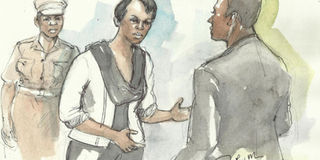The defective evidence used to convict Jackeline Uwera

Two people witnessed, and therefore knew, what truly happened and transpired when Mrs Jackeline Uwera Nsenga drove a car that crashed into the gate at her home on the evening of January 10, 2013 and killed her husband. The people were Mrs Uwera and her husband.
Mrs Uwera was prosecuted for the murder of her husband and the prosecution’s case was built on circumstantial evidence to demonstrate the element of malice aforethought. However it is now settled in law that when a case rests entirely on circumstantial evidence, such evidence must satisfy three tests;
• The circumstances of the case must be firmly established and persuasive.
• The circumstances should point to the guilt of the accused person.
•The circumstances taken in totality should form a chain so complete that the conclusion drawn from them is the commission of a crime, and nothing else.
To the lawyers, the circumstantial evidence used to convict Mrs Uwera did not meet these principles of law; the evidence was neither definite nor unerring and did not form a chain so complete as to provide no escape from the conclusion that Mrs Uwera caused the death of her husband deliberately.
There were apparently several circumstances which court did not consider which ultimately broke the chain of circumstantial evidence.
The Supreme Court, in an earlier case, ruled that concerning circumstantial evidence, it must be carefully examined because evidence of this kind may be fabricated to cast doubt on another person.
It is, therefore, necessary before drawing the inference of the guilt of the accused from circumstantial evidence to be sure that there are no other co-existing circumstances which would weaken or destroy the inference.
Scientific evidence
The forensic team that examined the scene of crime concluded that the gate was closed, that is, it was not open by the time it was rammed into by the car. According to the team, it was impossible for the driver to see who was opening the gate.
Mrs Uwera also told court that she could not see who was opening the gate nor could she have known that it was her husband opening the gate as he had never done so before.
According to the evidence on record the deceased also told his brother that this was his first time to open the gate.
The question then is: if the gate was closed as demonstrated by scientific evidence, if the deceased had never opened the gate for his wife before, how then did Mrs Uwera know that on this fateful day it would be her husband to open the gate for her, in order for her to form the intention to cause his death?
The trial court ignored these glaring facts which showed that there could not possibly be any intent on the part of Mrs Uwera to cause the death of her husband.
Post-mortem evidence
The post-mortem examination indicated that the cause of death of Mrs Uwera’s husband were multiple injuries consistent with the fact that the body of the deceased was dragged over a rough surface.
This means that the deceased was run over but not knocked by the car. The scientific evidence and post-mortem examination report all point to the fact that the deceased was hit by the gate then run over by the car.
For the prosecution case to stand, the prosecution would have to prove beyond reasonable doubt that Mrs Uwera knew it was her husband going to open the gate and deliberately run over him thereby causing fatal injuries. There was no evidence on the record to that effect. In light of these facts, the lawyers submitted that it not only takes a special murderous intent but also a suicidal one for one to drive a car into a closed gate.
If the gate was closed as shown by the evidence on record, then there were no grounds for the trial court to conclude that what happened was intentional rather than accidental.
The car
Evidence on the record was to the effect that although there have been unintended acceleration in selected Toyota models such as Camry, Avalon and Corolla in the United States of America, the Toyota Mark X 300G was not among the reported cases of unintended acceleration based on accessible literature.
Mrs Uwera’s lawyers submitted that the Prosecution did not authoritatively rule out that Mrs Uwera’s vehicle, the Toyota Mark X she drove that fateful day, was not among the models with unintended acceleration error.
In order to authoritatively rule out the possibility of accidental acceleration, the Prosecution ought to have adduced evidence to show that causative factors that caused accidental acceleration in some Toyota models were not present in the Toyota Mark X model, which they did not.
Further, the Prosecution could only rule out this by adducing evidence to show that the Toyota Mark X has absolutely nothing in common with the errant Toyota Models by way of engine, design or function.
To be continued




